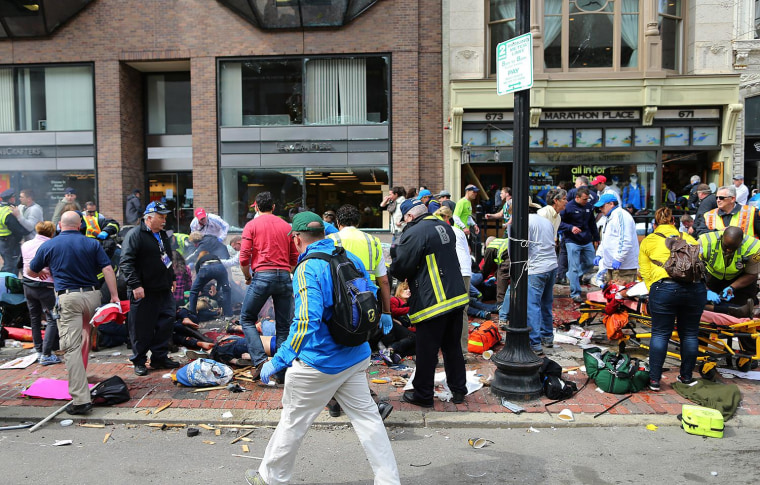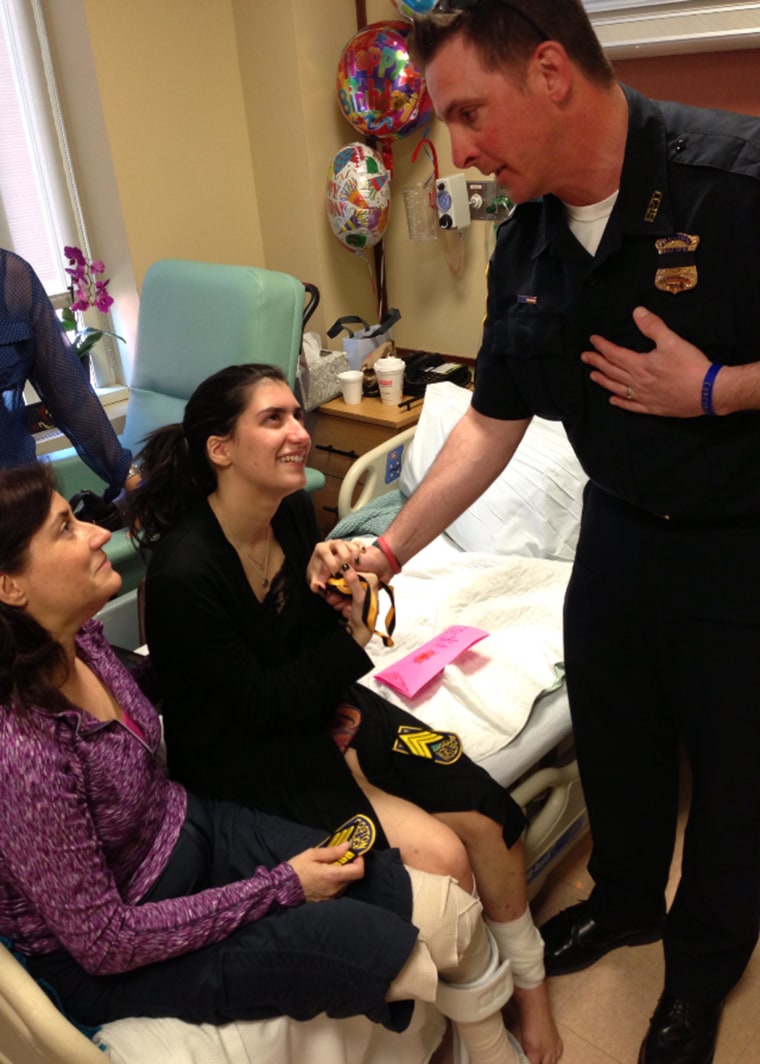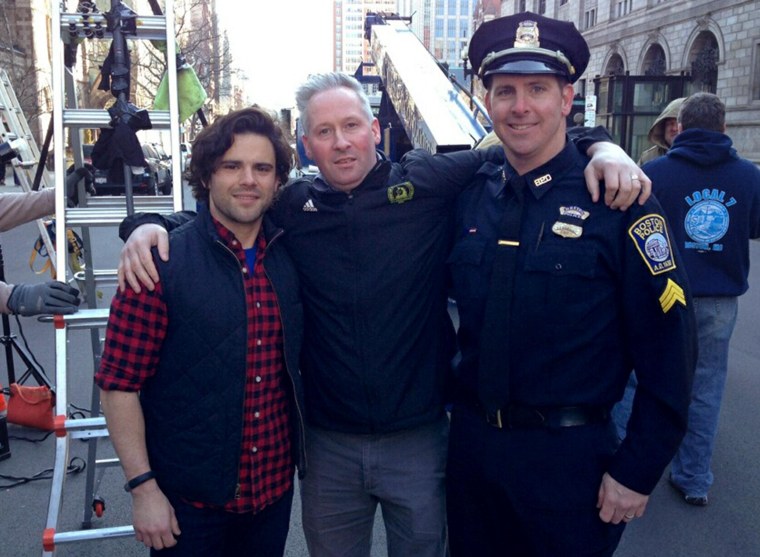BOSTON -- Sydney Corcoran was standing near the Boston Marathon finish line when the first bomb exploded, blasting her backward. She tried to run through the billowing smoke and falling glass, but couldn’t. Then she fell to the ground.
Her next memory is staring up at a man she’d never seen before. “You're gonna be OK, buddy. Just stay with me, buddy,” he said.
The man was one of many perfect strangers who ran toward the danger instead of away from it on that horrific afternoon of April 15, 2013. Though many lacked any formal emergency training, in just a few heartbeats they were enrolled in an army of first responders that was later credited with saving many lives.
Corcoran, then 17, had been standing next to her parents, Celeste and Kevin, when the first of two bombs on Boylston Street went off just a few feet away.They were there to cheer on Sydney’s aunt, Carmen Acabbo, who was running her first marathon. Shrouded by thick smoke, Corcoran couldn’t see her parents anymore. She tried to put weight on her right foot, but couldn’t. She then stumbled over to a guard rail and slowly slid to the ground.
She knew something wasn’t right, but what she didn’t know was that a piece of the pressure cooker bomb roughly the size of a cellphone had pierced her right thigh, severing her femoral artery and causing her to lose a lot of blood very quickly.
“The next thing I remember is I'm flat on my back, looking up and there's a man who has his forehead to mine,” Corcoran recalls.
That man was Matt Smith, a 36-year-old from Dorchester, Mass., who had been celebrating a time-honored tradition with friends before the explosion.

Smith still can’t explain why he ran toward the smoke and screaming. Before he did, he told his friends to run as fast as they could away from the scene.
“I just knew something was wrong. I had never been in the military or any first-responder-type job, but I just knew I had to help,” Smith said.
He found Corcoran lying on the ground outside of Marathon Sports, where one stranger was already at her side. (That individual wishes to remain private, but he is seen in many photos and videos from that day with his T-shirt off. He had removed it to put it under Corcoran’s head as a makeshift pillow.)
As soon at Smith knelt down, he took over and another man, Zachary Mione, darted into the store to grab shirts to use as tourniquets when he saw how bad Corcoran’s wound looked.
Corcoran was one of more than 260 people injured that day. Remarkably, thanks to the quick thinking and selflessness of first responders, every person with injuries who was taken to a hospital survived.
Though Smith and Mione didn’t have any first responder training, there were many people near the finish line who did. Every year, the Boston Athletic Association staffs dozens of military and trained medical personnel on Boylston Street to assist with runners’ injuries. No one could have imagined, however, how much their expertise would be needed.
'Extraordinary work'
The site was cleared of victims with serious injuries within 22 minutes, according to a Harvard study on the attack, and they were rushed to nearby hospitals very efficiently, since streets were closed and ambulances could get through with relative ease.
“I personally want to thank the extraordinary first responders for their just extraordinary work,” Gov. Deval Patrick said at a press conference the day after the bombing. “Those who were on site and those who got to the site promptly thereafter performed beautifully.”
Mione and Smith, the bystanders who worked furiously to prevent Sydney Corcoran from bleeding out, say the seconds and minutes after they reached her are an absolute blur.
But Corcoran has some vivid memories.
“I can remember a cop coming over and he was trying to ask my name, and they're all trying to keep me talking and awake,” Corcoran said. That cop was Sgt. Shawn Burns, an officer with the Boston Police Department for 13 years. Burns has worked the marathon almost every year since he started and it’s one of his favorite days of the year. He saw Corcoran sprawled on the ground and helped direct Mione and Smith on how to apply pressure and tie the tourniquets off.
“It may have been 30 seconds but it felt like two hours. It felt like forever,” Burns says of the moments after the first blast. In reality, it was only a matter of minutes before Burns, Mione and Smith were able to carry Corcoran away from the scene and onto a gurney so they could race her over to the medical tent, where the paramedics took over. All three distinctly remember thinking that she might not make it.
Burns accompanied Corcoran all the way to the ambulance, where several people thought he must have known her because of the way he was talking to her.
“I was talking to her like we had known each other for years. Just to keep her awake and feeling safe,” he said.
Burns had also grabbed Corcoran’s purse and “clutched it like a little old lady.” Even though the distance from the scene of the first explosion to the medical tent was only a few hundred yards, he said it felt like the longest run of his life.

Throughout all of this, Corcoran had no idea what had happened to either of her parents. Later, she learned that she ended up at the same hospital as her mother, Celeste, who had to have both of her legs amputated. Corcoran’s father, Kevin, was miraculously uninjured.
The next morning, Smith saw the now infamous photo (featuring him, Corcoran and Mione) on the cover of The Boston Globe and The New York Times and found out that she was being treated at Boston Medical Center.
Smith went to the hospital and asked to see her, but due to the heightened security, he was not allowed in. Finally, a security guard informed the family that Smith was waiting and Kevin went out to meet him.
“He asked me so many questions,” Smith remembers. Kevin wanted to make sure Smith was who he said he was and ultimately broke down in tears and embraced him, thanking him for what he had done, Smith said.
The doctors later told Celeste and Kevin that if those strangers hadn’t created tourniquets and kept Corcoran calm the way that they did, she likely would not have made it.
When he finally met her in the hospital, Smith says, he felt like he had known Corcoran forever.
That inextricable bond is deeply cherished by both Smith and Burns, who was also reunited with Corcoran at the hospital the week after the bombing. Today, they text or talk with Corcoran almost daily.
Mione didn’t see or speak with Corcoran again until five months later. He didn’t want any media attention and went back to Oregon in the days after the bombing. It was only when he had to come to Boston for a work trip that he decided to contact the Corcorans. At first, he says he felt pretty awkward about it but now Mione counts Sydney as part of his family.
“Anything she needs, anything she wants, she has from me for the rest of her life,” Mione said.

Though they’ve kept in touch over the phone, Mione, Smith and Burns were reunited for the first time in person earlier this month. They tried to piece together some of the details of that day, though much of it is still hazy for Mione and Smith. Burns, however, remembers what happened with astounding precision, down to what everyone was wearing. As a cop, he’d been trained to identify descriptions instantly.
Burns still marvels that while he knew more or less what to do in the situation, Mione and Smith had no first-responder training, but rushed in to help anyway.
“Those two guys made a decision to get down on their hands and knees and their actions saved that girl’s life. For me, that’s my job. I think I would have done it whether I was working or not but they didn’t have to stay and they did,” Burns said. “They are heroes in my book. No doubt about it.”
Smith considers himself the furthest thing from a hero. “All I know is that I did a good thing. I was just there to help this girl have a great rest of her life,” he said.
Smith will be back on Boylston Street on April 21, the day of this year’s race, to support Burns and Mione, who will be running the marathon for the first time this year, accompanying Sydney’s aunt. And though it will no doubt be difficult, Sydney and Celeste will be right there at the finish line, hoping to do what they never could last year because for them, it’s also about closure.
“It’s going to be so difficult to be there at the same exact spot as last year but somehow it’s OK,” Corcoran said. “We have to finish what we started.”
